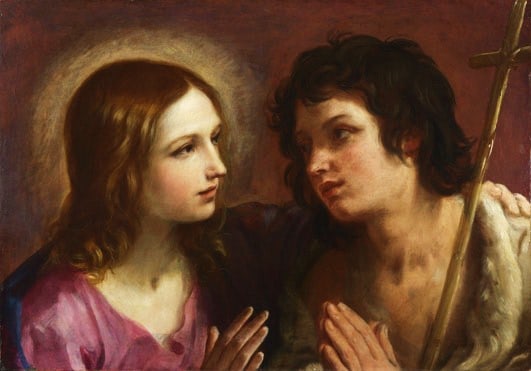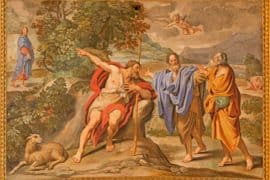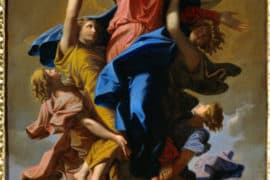In this new six part series I present responses to essays offered in my course at UNC Charlotte on “John the Baptist.” John is the most underrated figure in Christian tradition, rarely given his due as a messiah and inaugurator of the movement Jesus himself arose from. The responses are by my former student, Jeff Poplin, now a USAF Lt Colonel and fighter pilot, graduated with honors from the Air Force Academy, married with children. Jeff wrote them without notes in response to exams given in the course! They offer a good, concise, and rather extraordinary summary of what we covered in the course:
Topic: From an historical-critical point of view, what do we know about John the Baptist and how do we know it? Given the plethora of ancient sources, both independent and secondary, what appear to be the “indisputable” facts about John the Baptist, his life, career, mission, practices, and teachings. Show how our various sources can be critically examined to sift through redundant, contradictory, or even superfluous materials to arrive at something reasonably “settled” from an historical point of view. From your point of view do you find the approach of the “Jesus Seminar” as reflected by Tatum to be validated or questioned in terms of historical methodology, and why? Some of the major sources you should consider are: Q, Mark, Luke-Acts, Matthew, Thomas, Josephus (Greek and Slavonic), Pseudo-Clementines, Shem-Tov Matthew, later Gospels (Ebionite, Nazoreans, and Hebrews in quoted fragments, Infancy Gospel of James), and Mandean traditions…
Throughout the course of this semester we have examined biblical, independent, and secondary sources relating to John the Baptist and the world surrounding him during the early first century of the Common Era. Each ancient source contributes its own distinct view and piece of the historical puzzle of recreating the life, mission, and teachings of John. As the end of the course is near, we now need to look back from a historical-critical point of view to see what can be known about John the Baptist and how we know it. Some of these major sources include Q, Mark, Matthew, Thomas, Josephus, Pseudo-Clementines, Infancy Gospel of James, Shem-Tov Matthew, and later gospels of the Ebionites, Nazoreans, and Hebrews. Each one presents its own unique depiction of John and events surrounding his life and will be examined closely. Starting with biblical material, the Lukan version of Q should be examined first. In 7:24-26, Jesus is speaking to a crowd of people concerning John and asking what it is they went out to the wilderness to see? He asks the same question three times and finally says John is “more that a prophet.” Jesus also tells the crowd in 7:28 that “among those born of women none is greater that John.” From Q, it is learned John “came eating no bread and drinking no wine.” In 16:16, it states “The law and prophets were until John came; since then the good news of the kingdom of God is proclaimed.” A possible original teaching by John the Baptist may be found in 16:18 (although not formally considered part of Q) and it reads, “anyone who divorces his wife and marries another commits adultery, and whoever marries a woman divorced from her husband commits adultery.” Finally, from Q scholars are presented with a prayer, by Jesus, which John taught his disciples – “Father, hallowed be thy name, thy kingdom come. Give us each our daily bread; and forgive us our sins, for we ourselves forgive everyone who is indebted to us; and lead us not into temptation.”

Mark also presents various traditions on John the Baptist. From Mark, one learns John appears and is baptizing in the wilderness (1:4). An important commentary on John’s clothes is contained in 1:6 where it describes garments of “camel’s hair with a leather girdle around his waist.” It goes on to state he ate locusts and wild honey. Scholars are also able to retrieve from Mark traditions of his baptism of Jesus in the Jordan river, Herod’s arrest and execution of John because of Herodias, and that John’s disciples fast while those of Jesus do not (2:18).
Matthew too contains biblical material concerning John. Here is found references to John’s clothing of camel hair and a leather girdle and to his dietary habits of eating locusts and wild honey. John’s baptism is explained as a baptism of repentance (3:11) and that he baptizes Jesus (3:13). Found in 11:9-12, Jesus is addressing a crowd, telling them John is indeed more than a prophet, among those born of women there has risen no one greater than John, and the law and prophets were until John. Matthew also portrays John coming neither eating nor drinking (11:18). From Matthew, one learns of John’s arrest (14:3), his objection to Herod’s adultery (14:4), and his death at the request of Herodias (14:5-13). Finally, in 17:12, Jesus is speaking with the inner three concerning Elijah’s coming and says “Elijah has already come,” referring to John.
The last biblical material on John comes from Luke-Acts. From this material it is known that John is six months older that Jesus and their mothers (Mary and Elizabeth) are related, cousins perhaps. In Luke 1:80 it is revealed John grew up in the wilderness from childhood and remained there “until the day of his manifestation to Israel.” Luke 1:15 explains John as being given a Nazirite vow (while still a child) and as a requirement of that vow “he shall drink no wine or strong drink.” John’s baptism is for repentance and appears to be the only one taught in Alexandria and known to Apollos until his meeting with Paul (Acts 18:24-19:1).
Knowledge of John and his role in the early “Christian” movement would not be possible by a study of biblical material alone. Continuing the search, we find a wealth of independent and secondary sources that contain numerous references to John the Baptist. First on this list is the Gospel of Thomas, which like Q is a sayings gospel containing 114 sayings of Jesus. It was discovered in 1945 near Nag Hammadi, Egypt where it is believed they remained buried since the 4th century. Only one in the entire gospel explicitly reefers to John. In 46:1-2 it reads, “Jesus said ‘From Adam to John the Baptist, among those born of women, no one is so much greater than John the Baptist that his eyes should not be averted’.” Thomas 52:1-2 is not specifically about John the Baptist, yet may be read as referring to him indirectly. It states, “his disciples said to him (Jesus) ‘Twenty-four prophets have spoken in Israel and they all spoke of you.’ He said to them ‘you have disregarded the living one who is in your presence, and have spoken of the dead’.”
Next comes the respected Jewish historian Josephus. There are two copies of his work: one Greek and the other Slavonic, each adding information to this evolving story. First, in the Greek version we find a reference to John in Antiquities of the Jews – written in the 90’s while Domitian is in power. This work is a little more liberal with information than the earlier Jewish War and as such might be the reason John is mentioned. King Herod’s army had a battle with the neighboring King Aretas and Herod suffered a military defeat. Josephus records that some of the Jews thought the destruction of Herod’s army came from God as a punishment of what he did against John. Herod feared John’s influence over the people and as a result had John sent out to Macherus where he was eventually beheaded.
Recorded in the Slavonic version of Josephus we find that John would not allow wine or intoxicating drink anywhere near him. Also, that his lips “knew no bread,” so much so that he did not even eat the unleavened bread traditional at the Passover feast. It is recorded John put animal’s hair upon his body wherever it was not covered by his own hair. John dipped or cleansed the people who came to him in the waters of the Jordan. Slavonic Josephus also records that John ate only natural things: locusts and wild honey.
The group of writings known as the Pseudo-Clementines claim to be the work of Clement (of Rome). Possibly written in the early 3rd century, the works, valuable for our purposes, record a discussion between Peter and Clement regarding Jewish sects and the disciples of John the Baptist. The first of two references records in 1.54.8, “Now the pure disciples of John separated themselves greatly from the people and spoke to their teacher as if he were concealed.” Could this be an early reference to the Mandeans? The second reference comes from 1.60.1-4 where the disciples of John are talking with the disciples of Jesus and saying, “He (John) is the Christ and not Jesus…just as Jesus spoke concerning him, namely that he is greater that any prophet who had ever been.” They also say John is greater than Moses and Jesus and therefore he is the Christ.
Another interesting source to be considered is Shem-Tov’s Hebrew Matthew. Written in the 14th century, a treaties written by Shem-Tov contains a Hebrew version of the complete text of Matthew. It contains several differences from the Greek copy of Matthew regarding John the Baptist. In 11:11 Jesus says, “among all those born of women none has risen greater than John the Baptist.” Shem-Tov’s version ends the sentence here without adding the phrase concerning those least in the kingdom being greater than he. Recorded in 11:13 it states, “For all the prophets and the law spoke concerning John” unlike the Greek version’s “law prophesied until John.” There exist other early Christian literature classified as “gospels” which need to be examined in addition to the earlier gospels (Q, Mark, Matthew, Luke-Acts, and Thomas). These later gospels were probably written during the 2nd century C.E. and appear to be somewhat dependent (literally) upon the earlier Gospels. The first of these is the Gospel of the Ebionites. Epiphanius quotes passages of the Gospel of the Ebionites (sect of Greek speaking Jewish-Christians) in his work Heresies and is the reason scholars are able to have the three fragments concerning John today. In 30.13.6, the reader is made aware that John was baptizing for repentance in the Jordan River during the days of King Herod of Judea. The names of John’s parents are mentioned here as being Zechariah (a priest) and Elizabeth. The next fragment, 30.13-4-5, records John wearing a garment of camel’s hair and a leather belt around his waist and that he are wild honey and manna with oil (not locusts as in other writings). In the third and final fragment, 30.13.7-8, Jesus comes and is baptized by John. Next is the Gospel of the Nazoreans, which was probably written for Jewish-Christians, and scholars have a fragment of this work as recorded by Jerome in his work Against Pelagius. It is recorded that “John the Baptist baptized for the remission of sins” and he baptized Jesus (3.2). Jerome also records, in his Commentary of Isaiah, a quote from the Gospel of the Hebrews. Though John the Baptist is not specifically referenced, Jesus’ baptism is and that event is generally held that John is the one who performed the duty. The Gospel of the Hebrews has the Holy Spirit coming upon Jesus as he emerges from the water as if he were the perfect human (human to Divine: late called “Adoptionism”). Last of these later gospels is the Infancy Gospel of James of Protoevangelium of James, which claims to have been written by Jesus’ brother James. This was probably done so to give the work some creditability because James was the leader of the Jerusalem Church after the death of Jesus, although he is doubted as having actually written it himself. Two passages in this work deal directly with John the Baptist. In the first, 22:5-9, the name of John’s mother is given as Elizabeth and it tells of how she hid John from Herod as he was slaughtering infants (for fear he too would be killed). In the second passage, 23:1-9, John’s father’s name is recorded as Zechariah and it is told Herod had Zechariah killed for not revealing where his son had been hidden.
Taking a step back for a moment, we can now see the magnitude John plays in the history of the early “Christian” movement. An examination of the references to him, accompanied by their respective authors has just been presented. However, a question must be posed at this stage, what does this all mean? Armed with this knowledge, what can we say about John (what are the facts, how do we know them, and in what way are they presented)? Looking individually at the major source materials with a critical bye makes any reader question the accuracy of any one account, yet taken as a whole, the materials, texts, and traditions all push certain motifs and facts surrounding the life of John the Baptist. Although each text, source material, of tradition presents its own version of the occurrences surrounding John, we are able to extract the core meaning from such sources and can confirm their validity by cross-checking these with other known reliable sources. Certain aspects about John, his life, career, mission, practices, and teachings are held to be “true” with reasonable certainty, indisputable if you will. Scholars know the John was born in Israel to a mother and father named Zechariah and Elizabeth. He is living in the wilderness for most of his life. John is baptizing people who come to him in the Jordan River for the remission of sins/repentance. Jesus came and received his baptism from John in the Jordan River. John’s clothes consisted of a garment made of animal’s hair, most likely camel’s hair, with a leather belt around his waist and his diet consisted of wild honey and something else (manna or locusts/ekris or akris). We know that John came neither eating bread nor drinking wine (or intoxicating drink). It is also known that John objected to Herod’s taking of Philip’s wife and viewed it as an act of adultery. In reaction, Herod had John arrested and imprisoned (most conceivably at the desert fortress Macherus) and eventually ordered John beheaded. Scholars know John the Baptist was held in high regard by the people of Israel during his time and thereafter evident by the large numbers of people flocking to him in the wilderness, by John having disciples of his own, and by Jesus himself claiming that “among those born of women none has risen greater that John the Baptist.” John taught repentance and baptism as preparation for the time of God which was near. He accepted sinners into his ministry, taught that people should care for the poor, and spread the word of the coming kingdom of God. John taught devotion to God and rejection of world as displayed by his clothing, diet, and wilderness lifestyle. John also had devoted followers/disciples who viewed him as the Christ after his death and survive today as modern-day Mandeans living mostly in Iraq and Iran. It is only through the consolidation and consideration of all ancient sources: New Testament, Gnostic scriptures, traditions, church historians, independent and secondary materials (complementary and contradictory) that scholars can discover the original, historically accurate picture of John as a member, believer, and righteous leader of the early “Christian”/baptismal movement. Looking at the approach taken by the Jesus Seminar, it could be argued that their methods are questionable in terms of historical methodology. The Jesus Seminar claims to have considered all the available historical evidence related to John the Baptist and Tatum’s book is a summary of the seminars deliberations and votes to bring readers a concise sketch of the historical figure of John the Baptist. Their inclusion of Josephus, Pseudo-Clementines, and other early Christian gospels is commendable, yet their assessment and interpretation of such sources in constructing a historically accurate portrait of John may be suspect. It would appear the members of the Jesus Seminar have an underlying motive or agenda in their deliberations and votes. They appear to accept very little as “true” facts (i.e. there was a person named Jesus – 96% agree, John baptized Jesus – 91% agree, etc.). What the Jesus Seminar agrees on as fact (not much apparently) comes almost exclusively from the New Testament. Instances in which material is sketchy or comes from independent and secondary sources, the Jesus Seminar exclude it as fiction. Examples include John and Jesus being related – 5% agree, Mary and Elizabeth are related – 3% agree, Herodias’ daughter asked for John’s head of a platter – 24% agree. The Jesus Seminar’s approach quite possibly began with good and noble intentions but the methods they employed and the results of their study are flawed in terms of historical methodology.









Comments are closed.